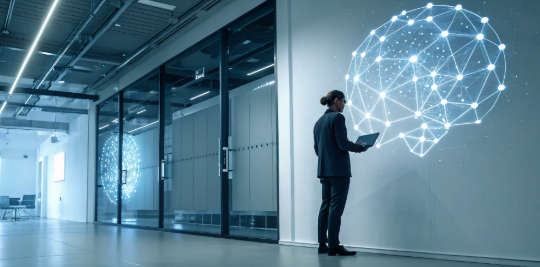Introduction: The GPU Reign and the Winds of Change
For over a decade, Nvidia has held a dominant position in AI infrastructure. Its CUDA ecosystem and general-purpose GPUs became the de facto standard for training and deploying deep learning models. But as Large Language Models (LLMs) continue to grow in size and complexity, cracks are beginning to form in the GPU-first paradigm.
Startups and hyperscalers alike are recognizing a hard truth: general-purpose hardware can't keep up with the increasingly specialized demands of modern AI. From the rise of Mixture of Experts (MoE) models to the push for real-time inference at scale, we're witnessing the emergence of a new AI hardware race.
This article explores how LLMs are driving a foundational shift in infrastructure and why a wave of specialized chips, novel architectures, and distributed computing techniques are threatening to unseat Nvidia's monopoly.
Part I: LLMs Changed the Game
From BERT to GPT-4: Exponential Growth
Transformer models began disrupting natural language processing in 2017. Since then, we've seen LLMs balloon in size from millions to hundreds of billions (and even trillions) of parameters. This exponential growth has triggered unprecedented demands on memory, bandwidth, and compute.
- Training Costs: State-of-the-art models now cost tens of millions of dollars to train.
- Inference Costs: Serving large models at scale is even more expensive and energy-hungry.
- Latency Demands: End-users expect millisecond-level latency, especially in real-time applications like chatbots, video generation, and autonomous agents.
Why Traditional GPUs Fall Short
Nvidia GPUs are versatile but inherently general-purpose. Their flexibility comes at the cost of efficiency:
- Underutilized compute for sparse models.
- High latency from memory-bound operations.
- Thermal limits that throttle performance.
These limitations are exacerbated when deploying LLMs, particularly at scale. Enter a new approach: sparse activation and modular execution.
Part II: Mixture of Experts (MoE) and Sparse Models
What is Mixture of Experts?
MoE is a neural network architecture where only a subset of the model's parameters are activated for any given input. A gating mechanism dynamically routes data through a small number of specialized sub-models ("experts"), reducing compute while maintaining or even improving accuracy.
Benefits of MoE:
- Massive scale with lower compute cost. You can have trillions of parameters but only activate a few percent per inference.
- Specialization. Experts can learn to handle different data types or linguistic patterns.
- Faster inference. Sparse activation means fewer matrix multiplications per forward pass.
Challenges:
- Load balancing. Ensuring experts are evenly used.
- Routing latency. Gating and dispatching add system complexity.
- Distributed deployment. Experts often live on different devices or even different nodes.
MoE architectures require a completely different approach to both hardware and software optimization. They are one of the key drivers behind the rise of custom AI accelerators.
Part III: The Rise of Specialized AI Chips
The New Players
A wave of startups is building AI chips purpose-built for LLMs and inference at scale. These chips are:
- Hard-coded for transformer operations.
- Optimized for low-latency, high-throughput inference.
- Sparse-aware, with support for MoE-style activation.
Some key characteristics of these next-gen chips:
| Feature | GPU (e.g., Nvidia A100) | New AI Chips |
|---|---|---|
| Programmability | High | Low-to-none |
| Performance per Watt | Moderate | Extremely High |
| Sparse Model Support | Limited | Native |
| Hardware Utilization | Varies | Near-max |
Why This Matters
AI workloads are converging toward a few dominant architectures: transformers, diffusion models, and graph-based networks. This consolidation allows hardware companies to hardwire specific operations, leading to order-of-magnitude improvements in efficiency and cost.
We're moving from general-purpose silicon to application-specific integrated circuits (ASICs) and domain-specific architectures (DSAs) built explicitly for AI.
Part IV: Infra Gets Smarter — Model Parallelism & New Software Stacks
From Data Parallelism to Model Sharding
Traditional distributed training used data parallelism: copy the same model across devices and split the data. But with trillion-parameter LLMs, that's no longer viable.
Today, companies are using:
- Tensor Parallelism: splitting individual matrix ops across devices.
- Pipeline Parallelism: breaking model layers into sequential stages across devices.
- Expert Parallelism: activating and routing inputs to specific experts.
These techniques require sophisticated runtime schedulers, profiling tools, and network communication protocols (like NCCL, MPI, or custom stacks).
The Rise of Custom Inference Runtimes
We're also seeing an explosion in bespoke inference software:
- vLLM for fast GPT-style inference.
- TensorRT-LLM from Nvidia for optimized transformer inference.
- Ray and Kubeflow for orchestrating distributed compute.
- Triton, XLA, TVM for compiling to low-level optimized kernels.
These tools are necessary because maximizing the performance of massive models is no longer just a matter of using PyTorch or TensorFlow. You need tight control over memory layout, kernel fusion, graph pruning, and hardware affinity.
Part V: Real-World Implications
Real-Time AI Becomes Possible
With custom infra and MoE models, we can now:
-
Generate video in real time.
-
Power low-latency chatbots with trillion-parameter backends.
-
Run powerful agents with deep reasoning chains.
Democratization of Scale
New infra approaches are also reducing the cost of inference, making cutting-edge AI accessible to smaller companies — not just hyperscalers.
Talent Shifts in AI Hiring
As AI infrastructure gets more complex, companies are hiring:
- ML Systems Engineers who understand model deployment, not just model training.
- Hardware-aware ML experts who can work across software and chip-level constraints.
- Distributed systems engineers fluent in parallelism, profiling, and scheduling.
Conclusion: The Future is Hardware-Software Co-Design
LLMs have ushered in a new era of AI infrastructure where hardware and software are co-designed from the ground up. Nvidia’s dominance, while still strong, is no longer unchallenged.
Startups are proving that if you know your model architecture, you can build hardware that dramatically outperforms general-purpose GPUs. And with techniques like MoE, model parallelism, and compiler-level optimization, the entire stack is being rebuilt for scale.
At People in AI, we specialize in helping companies find the rare talent that thrives in this hybrid world of distributed AI systems, custom hardware, and deep ML infrastructure. Whether you're scaling a new LLM product or building a next-gen AI inference platform, we know the candidates who can make it real.
Need help hiring AI infra experts? Let's talk. Reach out to the People in AI team today.















